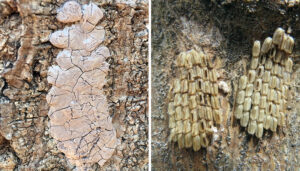The spotted lanternfly is an invasive pest that has been making its way through the eastern United States. It is now a growing concern for homeowners and businesses here in Central Virginia. Keep reading to learn what these insects are, why they pose such a big threat to the Central Virginia region, and how we can eliminate them.
What Are Spotted Lanternflies & How Did They Get Here?
The spotted lanternfly is a planthopper native to China, Vietnam, and India. First detected in Pennsylvania in 2014, they are believed to have arrived in the U.S. on imported materials. Since then, they’ve spread rapidly across the mid-Atlantic, hitchhiking on vehicles, outdoor furniture, firewood, and even clothing.
Spotted lanternflies have rapidly multiplied in Virginia because they have few natural predators. They spread easily by hitchhiking on vehicles and outdoor materials, allowing them to quickly colonize new areas.
These insects are easy to identify. Adults are roughly 1 inch in size, have grayish wings with black spots, and when opened, they reveal bright red underwings. Their nymphs, which appear earlier in the season, are black with white spots and later develop red patches.
Adult spotted lanternflies lay yellowish-brown egg masses and cover them with a gray, waxy coating. They’re most active from mid-July until a hard frost in late fall, and typically lay their eggs around mid-September.

Left: Unhatched egg masses. Right: Mass with some eggs hatched. Photos by Emelie Swackhamer, Penn State University, Bugwood.org (left photo) and Kenneth R. Law, USDA APHIS PPQ, Bugwood.org (right photo).
Why Are They a Threat to Central Virginia?
The spotted lanternfly isn’t just a nuisance—they’re a serious threat to agriculture and the environment.
- Damage to Trees & Plants: Spotted lanternflies feed on over 70 plant species, including grapevines, fruit trees, hardwoods, and ornamentals. They suck the sap out of trees which weakens plants and makes them more vulnerable to disease.
- Threat to Vineyards & Farms: Virginia’s thriving wine industry and agricultural crops are especially at risk with lanternflies causing significant economic losses in affected areas.
- Honeydew & Mold Problems: As they feed, lanternflies excrete a sticky substance called honeydew, which encourages black sooty mold to grow—coating patios, outdoor furniture, and even cars.
- Rapid Spread: They lay egg masses on almost any surface, from trees to vehicles, making it easy for them to spread into new areas quickly.
So what can you do to help with the spread of the spotted lanternfly? Continue reading to learn how you can help!
How To Stop The Spread of Spotted Lanternflies
If you see a spotted lanternfly or their egg masses, here’s what you should do:
- Stomp Them – The Virginia Department of Agriculture encourages residents to kill spotted lanternflies on sight. Every one destroyed helps slow the spread.
- Scrape Egg Masses – They look like grayish, putty-like smears and can be found on trees, stones, decks, and even outdoor furniture. Scrape them into rubbing alcohol or hand sanitizer to kill them.
- Report Sightings – Reporting helps track their spread. In Virginia, you can submit reports to the Department of Agriculture and Consumer Services.
- Be Careful When Traveling – Check your car, firewood, and outdoor items to make sure you’re not accidentally transporting these pests to new areas.
There’s also a few things you can do around your property to help kill them and stop the spread.
- Remove Tree-of-Heaven From Your Property – Spotted lanternflies host on these trees so by removing these trees, it can lower the population.
- Plant Milkweed – Planting native plants like milkweed can also help restore balance by supporting pollinators, which play a vital role in keeping our ecosystems healthy. They are attracted to the plant’s sweet sap, but they do not recognize the cardiac glycosides within it that are toxic to them. Feeding on common milkweed has been shown to kill 60-80% of spotted lanternfly nymphs and adults within 24 hours, making it a natural and eco-friendly “trap crop”.
How Monticello Pest Solutions Can Help
There is currently no permanent solution to eliminate spotted lanternflies. However, professional management can make a big difference in reducing populations around your home or business. At Monticello Pest Solutions, we provide:
- Exterior Treatments: Power sprays to the foundation, trees, and plants where lanternflies gather and feed.
- Targeted Crack & Crevice Applications: Reducing hotspots where they hide and lay eggs.
- Integrated Pest Management (IPM): Combining treatment with homeowner education to slow the spread and protect your property.
Our goal is not only to help you manage spotted lanternflies on your property, but also to be part of the community-wide effort to protect Central Virginia’s landscapes and agriculture.
Spotted lanternflies are an invasive pest that requires all of us to take action. If you’re seeing them around your property, Monticello Pest Solutions is here to help you manage the problem. Contact us today to schedule an inspection or treatment.

